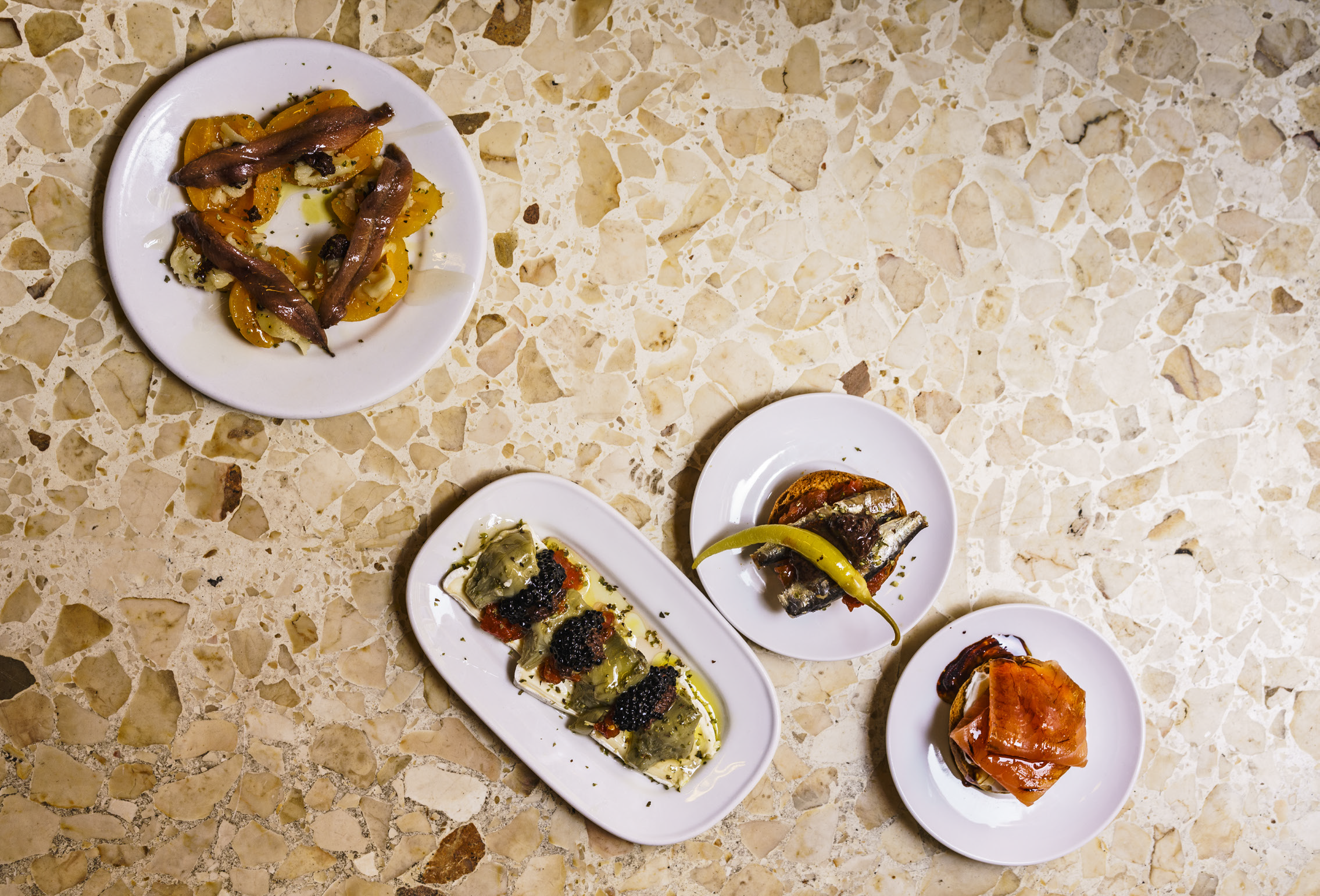On the northeastern tip of Spain, all the best snacking happens before noon with a chilled bottle of vermouth.
The Brits have their afternoon tea. The Italians set aside a few hours before dinner for a bitter aperitivo and a few pieces of cheese or olives. In New York, we have an expensive meal that happens somewhere between breakfast and lunch on weekends and tends to involve waiting in line, drinking bloody Marys, and telling sordid tales of the previous night.
But in Catalonia, the Mediterranean region that hugs the northeast coast of Spain, the ultimate lazy weekend routine is known as l’hora del vermut, or vermouth hour. As Daniel Olivella writes in his new book, Catalan Food, the ritual tends to occupy the time in the middle of the day, after church but before lunch. It’s an opportunity to pull out a bottle of chilled vermouth, open a few tins of sardines or mussels, and put out any other low-maintenance snacks you have around.
Like an Italian aperitivo (think Campari or Aperol), vermouth tends to be herbal, bitter, and sometimes a little bit peppery. The fortified wine is a perfect counterpoint to everything salty, briny, garlicky, and pickle-y. That might include potato chips, padron peppers dusted with adobo seasoning, bits of ham, pickled anchovies, olives, or crusty bread rubbed with raw garlic and tomato flesh, known as pa amb tomàquet (or sometimes pan con tomate).

“Pa amb tomàquet can accompany almost any food,” says Olivella. “Often you eat Iberico ham or an omelette with pa amb tomàquet on the side.” The tomato gives the bread a fruity, acidic flavor, but it also softens it, creating a way to extend bread that’s verging on stale. The small, hearty Catalan tomatoes that are generally used are called tomàquet, or tomacons.
“The skins are tough, so they don’t make good salad tomatoes,” says Olivella. “But when you cut and rub tomacons on grilled bread, the juicy flesh smears all over the bread, leaving behind the tough tomato skin like a shell. It’s the perfect use for them.” If you’re making pa amb tomàquet in the United States, don’t worry about getting the type of tomato exactly right. You’ll find comparable results from any small, round vine tomatoes that are ripe.
Pickled anchovies, another staple of Catalan snacking and a popular topping for pa amb tomàquet, are much harder to find outside of Spain. Luckily, if you find a source for fresh ones and you have a little bit of patience with filleting (and maybe a couple YouTube tutorials to help), you can make them yourself.
“We put a pickled anchovy recipe in the book for the lucky few Americans who can get their hands on fresh anchovies,” says Olivella. “Pickling them makes the anchovies last for up to a week, and they taste so much better than canned or packaged anchovies.” Since marinating the fresh fish in olive oil and vinegar acts as a natural preservative, if you make a batch this weekend, you can just kick back with some ice-cold vermouth when next weekend rolls around. Not a bloody Mary in sight.
Ingredients
- 1 round or long loaf crispy bread, such as ciabatta
- 2-3 garlic cloves, peeled and halved
- 2-3 small vine tomatoes, halved crosswise
- Extra-virgin olive oil
- Flaky sea salt
Pa amb tomàquet is the foundation of every sandwich in Catalonia. If the smear of tomato is missing, it gets sent back to the kitchen. Though it can be topped with a variety of tasty sausages or tinned fish, the basic recipe is difficult to improve upon. Look for ripe and soft tomatoes that have been stored only at room temperature. The proper bread will have a crisp crust. You also don’t want the loaf to be too tall (about 2 inches tall at most) because you will halve the entire loaf horizontally so the crust is on either side. If you’re making this recipe for a crowd, grate the pulp from halved tomatoes, then use a spoon to spread it onto the toasts. It goes faster that way, and the bread won’t be soggy by the time you’re ready to serve it.
- Slice the bread in half horizontally, as if for a sandwich. Cut the bread halves crosswise into rectangles or squares, 4 to 5 inches in diameter, and toast them in a toaster or toaster oven until golden brown, 2 to 3 minutes. You can also toast them under the broiler or on a grill for 1 to 2 minutes per side.
- Gently rub the cut sides of the garlic cloves all over the crispy sides of the toast. Then rub the cut sides of the tomatoes over the toast until the tomato pulp falls apart and seeps into the nooks and crannies. When the tomato halves have given up all their pulp and are completely spent, discard the remaining tomato skins and cores. Be sure the tomato pulp is spread evenly to all corners of the bread.
- Drizzle the toast with a generous amount of olive oil, then sprinkle with salt. Sometimes I like to press the oily sides of the toasts together to help squeeze the oil deep into the toast. You can also cut each toast square on a diagonal to make triangles.
Ingredients
- 1 cup red wine vinegar
- 1 teaspoon kosher salt
- 12 ounces fresh anchovies, filleted
- 1 tablespoon finely chopped fresh curly parsley
- 1 tablespoon finely chopped garlic
Fresh anchovies are very hard to come by outside of Spain. I tend to save this recipe for trips home in the summer, where it’s easy to find them. If you can get your hands on these small fish (beg your favorite fishmonger or even try a bait shop near a fishing town), this recipe is incredibly simple and worth making. The key is recognizing the freshness of the fish: They should smell clean, like the ocean, and not “fishy.” The skins should be firm and shiny, particularly around the bellies. Even though boquerones—the Spanish name for this pickled preparation of anchovies—hail from Santander in Spain, we Catalans love them, too. We just prefer to call them seitons.
In Catalonia, we eat seitons with nothing but chilled vermouth. You could also serve them with sliced pears and Idiazabal cheese.
Filleting Fresh Anchovies
- Hold the fish under running water over a medium bowl to catch the discarded bits. Using the dull side of a paring knife, scrape away the scales from the body, working from head to tail. Place your fingers below the gills and snap off the head, pulling out the innards with it. Use a paring knife to slit the belly and rinse out any remaining innards. The fish will naturally begin to butterfly, and you will see a fillet on both sides of the belly. Flatten the fish with your fingers until it is fully butterflied. Lift the tail to pull the backbone away from the flesh, discarding the backbone. Slice or pinch off the top fin and tail of the fish.
Pickled Anchovies
- In a medium shallow dish (big enough to hold the fillets in a single layer), combine 1 cup water and the vinegar. Stir in the salt. Layer the filleted anchovies on the bottom of the dish, skin side down. Set aside until the fish flesh turns white, about 1 hour.
- Drizzle a layer of oil over the bottom of a small glass dish just big enough to hold all of the anchovies comfortably. Removing the anchovies from the vinegar mixture one at a time, and allowing the excess liquid to drip off, make a layer of fish in the smaller dish. Drizzle the fish with more oil, then scatter on a pinch each of parsley and garlic. Repeat the layering until all have been used up. Add enough oil to cover the anchovies completely. Cover the dish and refrigerate for at least 3 hours before serving. Seitons will keep for up to 1 week; as you use them, be sure the remaining anchovies are covered in oil.
Ingredients
- 4 teaspoons vegetable oil
- 2 teaspoons extra-virgin olive oil
- 4 medium garlic cloves, thinly sliced
- 8 medium tail-on shrimp (2½5 count), peeled and deveined
- ½ teaspoon adobo seasoning plus a generous pinch of pimentón (smoked paprika)
- 1 tablespoon finely chopped fresh curly parsley, for serving
My deepest memories come from playing around in the kitchen as a boy while my mother cooked. The savory aroma of sofregit and the smell of frying garlic always remind me of her, as do the smells in this dish. I like to serve it to guests in small cast-iron skillets with the shrimp and garlic still sizzling. The aromas of garlic and oil waft up from the pan, engulfing your senses.
- In a cold 6-inch cast-iron skillet, stir together the oils and garlic. Tuck the shrimp together in a single layer on top. Place the skillet over medium-high heat and sprinkle a generous pinch (about ¼ teaspoon) of adobo seasoning over the shrimp as they begin to sizzle. Sear the shrimp until they are pink on one side, about 2 minutes, shaking the pan once or twice to keep the garlic from burning. Use tongs to turn the shrimp and cook until they are bright pink, about 1 minute more.
- Sprinkle with the remaining adobo seasoning and remove the skillet from the heat. Let stand for about 30 seconds and serve the shrimp sizzling in the skillet.





